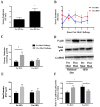Metabolic endotoxemia with obesity: Is it real and is it relevant?
- PMID: 26133659
- PMCID: PMC4695328
- DOI: 10.1016/j.biochi.2015.06.020
Metabolic endotoxemia with obesity: Is it real and is it relevant?
Abstract
Obesity is associated with metabolic derangements in multiple tissues, which contribute to the progression of insulin resistance and the metabolic syndrome. The underlying stimulus for these metabolic derangements in obesity are not fully elucidated, however recent evidence in rodents and humans suggests that systemic, low level elevations of gut derived endotoxin (lipopolysaccharide, LPS) may play an important role in obesity related, whole-body and tissue specific metabolic perturbations. LPS initiates a well-characterized signaling cascade that elicits many pro- and anti-inflammatory pathways when bound to its receptor, Toll-Like Receptor 4 (TLR4). Low-grade elevation in plasma LPS has been termed "metabolic endotoxemia" and this state is associated with a heightened pro-inflammatory and oxidant environment often observed in obesity. Given the role of inflammatory and oxidative stress in the etiology of obesity related cardio-metabolic disease risk, it has been suggested that metabolic endotoxemia may serve a key mediator of metabolic derangements observed in obesity. This review provides supporting evidence of mechanistic associations with cell and animal models, and provides complimentary evidence of the clinical relevance of metabolic endotoxemia in obesity as it relates to inflammation and metabolic derangements in humans. Discrepancies with endotoxin detection are considered, and an alternate method of reporting metabolic endotoxemia is recommended until a standardized measurement protocol is set forth.
Keywords: Endotoxin detection; Inflammation; Metabolic endotoxemia; Obesity; Substrate metabolism.
Copyright © 2015 Elsevier B.V. and Société Française de Biochimie et Biologie Moléculaire (SFBBM). All rights reserved.
Conflict of interest statement
The authors report no conflicts of interest. All authors have approved the final version of this manuscript.
Figures



References
-
- Ghoshal S, Witta J, Zhong J, de Villiers W, Eckhardt E. Chylomicrons promote intestinal absorption of lipopolysaccharides. J Lipid Res. 2009;50:90–97. - PubMed
-
- Cani PD, Amar J, Iglesias MA, Poggi M, Knauf C, Bastelica D, Neyrinck AM, Fava F, Tuohy KM, Chabo C. Metabolic endotoxemia initiates obesity and insulin resistance. Diabetes. 2007;56:1761–1772. - PubMed
-
- Bannerman DD, Goldblum SE. Direct effects of endotoxin on the endothelium: Barrier function and injury. Laboratory Investigation; a Journal of Technical Methods and Pathology. 1999;79:1181. - PubMed
Publication types
MeSH terms
Substances
Grants and funding
LinkOut - more resources
Full Text Sources
Other Literature Sources
Medical

